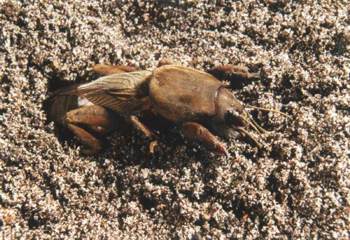Pests
Gryllotalpa gryllotalpa (L.) - Common Mole Cricket.
Systematic position.
Class Insecta, order Orthoptera, family Gryllotalpidae, genus Gryllotalpa. Three species are known in Russia besides G. gryllotalpa as follows: G. unispina Sauss., G. stepposa Zhantiev, and G. africana Palis.Biological group.
Polyphagous insect pests.Morphology and biology.
Length of body is 35-50 mm. Coloring brown with a silky shimmer, rather yellow on the underside, covered with thick, small hairs. Forelegs are of the digging type -- short, enlarged, with strong indentations. Hind legs have 3-4 inner spines. Prothorax elongate-ovate, 1.2-1.3 times longer than its maximum width. Elytra short, half the length of abdomen, coriaceous, with a net of thick veins. Wings are well-developed, transparent, with a dense net of veins, folding while not in use into plaits the project behind the end of abdomen. Long cerci at the end of abdomen are covered with dense hairs. Populates natural habitats, such as moistened and rich humus biotopes, river flood lands, and banks of reservoirs, as well as irrigated or well-fertilized fields and vegetable gardens. The complete cycle of development lasts from 1 to 2-3 years, depending on climatic conditions. Larvae pass through 6 instars; 3rd-5th-instar larvae and adults overwinter.Distribution.
G. gryllotalpa is widespread in Europe, except for in Scandinavia, the northern European part of Russia, southern Ukraine, and the Northern Caucasus. G. stepposa is found in Moldavia, the Northern Caucasus, Transcaucasia, and southern Turkmenia; data on the presence of G. gryllotalpa in southern Europe and North Africa probably refers to G. stepposa. G. unispina inhabits the northern Black Sea coast, The Caspian Sea coast, Kazakhstan, Central Asia, Iran, Afghanistan, and northwestern, central and southern China. Within the former USSR, G. africana occurs in the southern Primorskii Territory and the Amur Region; this species is widespread in the Old World, including Africa, tropical and subtropical Asia, Japan, Korea, and Australia.Ecology.
Dwells in soil, appearing on ground surface only occasionally. Flies at evening and at night. Floats well. Burrows holes in ground surface during warm times, while winter holes reach depths of 50-100 cm. Mass appearance after wintering is usually observed at temperatures of 12-15°C. After coupling, which takes place underground, female builds a nest. Egg batch consists of 100-350 or more eggs. Embryonic development lasts 10-20 days. Normal egg development requires 100% humidity. After eclosion, larvae remain in their nest under the guard of female for 2-3 weeks. Feeding and burrowing holes under ground, the Mole Cricket gnaws through the roots of plants, eating away tubers and rhizomes. It also feeds on many soil invertebrates, including insects and earthworms. Natural enemies include birds (rooks, starlings, etc.), insectivorous mammals (shrews, moles), ants (which destroy eggs), carabids (which feed on larvae), nematodes of the genera Oxyurius and Telestomum, and mites of the genera Neothorombium, Caloglyphus, and Rhizogliphus. During winters with thaws, fungal diseases may cause mass death of the pest.Economic significance.
Very general polyphage. Damages cereals, legumes, perennial grasses, potato, almost all vegetables, nearly all melons, nearly all gourds, beet, sunflower, tobacco, hemp, flax, and strawberry; it causes damage in hotbeds; in nurseries and young gardens, it damages vines, fruit trees, and many other tree species. Shoots and young plants often perish after damage. Control measures include deep autumn plowing, inter-row treatments of soil, trapping during winter, application of chemicals, use of poison baits, and soil fumigation.Related references.
Karaeva, V.Sh. 1959. To the study of Mole Cricket biology in Kabardino-Balkaria. In: Scientific transactions of Kabardino-Balkaria Univ., v. 6, ser. agric. and biol., Nalchik: Kabardino-Balkaria Univ. Press, p. 165-176 (in Russian).Klechkovskii, E.R. 1967. To the knowledge of natural pestholes and temporal reservations of Common Mole Cricket (Gryllotalpa gryllotalpa L.) in afforested flood-lands of Central Chernozem area. In: Harmful and useful insects. Voronezh: VEO AN SSSR, p. 233-238 (in Russian).
Kobakhidze, D.N. 1960. Common Mole Cricket in the USSR. Tbilisi: AS Georgian SSR, 60 p. (in Russian).
Kryzhanovskii, O.L. & Dantsig, E.M., eds. 1972. Insects and mites - pests of agricultural plants. V. 1. Primitive insects. Leningrad: Nauka, 323 p. (in Russian).
Shchegolev, V.N., Znamenskii, A.V. & Bei-Bienko, G.Ya. 1934. Insect pests on field crops. Leningrad & Moscow: Sel'khozgiz, 364 p. (in Russian).
Zhantiev, R.D. 1991. Mole Crickets (Orthoptera, Gryllotalpidae) of the European part of the USSR and the Caucasus. Zool. Zhurn., 70(6), p. 69-76 (in Russian).


